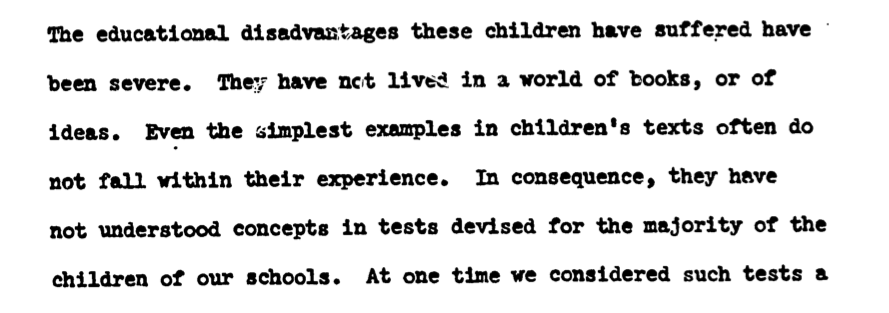Leaders, Civil Rights Leaders, People, what are we missing?
And how is it we don’t seem to understand that “narrowing the curriculum” translates to lost opportunities to learn — particularly in impoverished communities? Those communities were the ones previously targeted by the 1965 Elementary and Secondary Education Act (ESEA/NCLB). Those schools were the reason ESEA exists.
 Federal education law did not come into existence to dictate testing.
Federal education law did not come into existence to dictate testing.
So here are some facts that seem to be missing in the discussion of yearly standardized testing as it applies to reauthorization of No Child Left Behind/now the Every Student Succeeds Act (ESEA):
The original ESEA set this goal.
The only “accountability” and testing associated with this law was this:

“Appropriate” was to be determined by focusing on what children need to learn and staying focused on the “educationally-deprived” children.
Measurements of progress were used to assess effectiveness of federal dollars in meeting children’s learning needs. As one citizen recently expressed to me, these were state and locally created “measures.” …But back to the past,… in 1966, the first review of ESEA was released.

Yearly, the council was required to advise the president and congress. This council focused strictly on the children the law intended to help and advised we do the same.

This assessment of the problem, by this council, highlighted their thoughts on standardized testing.
This council understood that these children were coming to school already “disadvantaged” when it came to standardized test scores. Out-of-school factors played a role.

In other words, commercially designed standardized “achievement” tests point at opportunity-to-learn gaps.

Variation within a school is greater than between schools. We have to think about children from low-income families as children with fewer opportunities – unless their community provides them more.
Also in 1966, the Coleman Report said that family background and socioeconomic factors play a role in “achievement” – but it was interpreted to mean that “school resources” don’t matter.
However…….a point made in The Coleman Report that really is what makes the difference between great schools and mediocre ones is the concentration of poverty….if not properly addressed.
Fortunately, the 1965 ESEA was designed taking into consideration both in-school and out-of-school factors and later research by James S. Coleman would prove that an out-of-school safety net of opportunities (social capital) was a factor behind the success of the private Catholic schools that he studied. But as the story of testing goes….

Analysis and intervention must be focused on student learning – in the school where variability between students is largest.
Convinced that all students can learn, Ronald Edmonds looked at schools that began seeing student success regardless of their high-poverty rates. He not only analyzed the common factors in these “effective” schools, he looked at what they did to improve.
Edmonds did not shy away from standards and testing but his bigger focus was on instruction and learning….in the school.

Good-quality teacher-created tests focused on learning objectives in line with clear, locally acceptable standards should be considered as the alternative to yearly commercially-created standardized tests. Then, what gets taught gets tested.
So in light of the fact that the role of the federal government is to ensure our civil (citizen’s) right to equal access, the National Assessment of Educational Progress (NAEP) is one appropriate tool for assessing national or state achievement/opportunity gaps. We should not change something that has worked well as one indicator of our nations slow but steady progress.
Today, we must consider looking at the real core of the problem that national civil rights groups are having with the idea of giving up yearly standardized testing. We need to consider: when the biggest variable is within a school, when success is really defined by individual student success, student success can only be measured at the school level. The “accountability” measure must be determined by parents, teachers, and communities. Monitored by NAEP to assess inequality, yes. But any further national testing for this reason is not justified and is an overstep.
In federal program evaluations to satisfy “accountability” for dollars, the same data (measures, assessments, indicators) that are used to identify a problem should be used to determine whether the problem has been reduced or eliminated.
And one last lesson from the past that we may have missed, from No Child Left Behind, was that yearly standardized testing narrowed the curriculum to what was tested – it did harm – and instructional time was lost because of test preparation. Limiting learning opportunities in schools is most devastating for children whose parents can’t make up for those lost opportunities. I know this because I saw it with my own eyes.
I hope in the weeks to come that a set of meaningful indicators of educational quality and opportunity come out of the legislative debate on ESEA reauthorization. Yearly standardized achievement tests for all students should not be among them.
#TruthBeTold The civil rights movement marched on a different path to obtain equality in educational opportunity.
Congressional representatives, particularly those charged with re-writing NCLB, do you understand?
(UPDATE: they did not demonstrate understanding when they changed NCLB to ESSA – the Every Student Succeeds Act)
We are at a crossroads where the standards movement that has dominated education policy since the 80’s intersects with the almost forgotten educational history of the 60’s and 70’s that saw the natural progress of effective schools take root because the influential in education policy THEN understood poverty and saw a way that education law could remedy a longstanding injustice – unequal access to quality education.
It is a problem we can solve.





Many years ago I was principal of an elementary school serving mostly impoverished kids. I was in a city under court ordered busing to achieve a Black to Whit ratio comparable to the population of the city. That ratio was 60% white and 40% Black. The way the bus routes were gerrymandered it was all Black children who were bused in grades k thru 5.
For a short time we had a Superintendent who sought to use standardized testing to improve instruction for all children in the system. It involved accountability an I personally thought it was potentially excellent. I do not understand why nothing like it is ever even discussed in the never ending debate about school reform.
The first step was to develop a city-wide curriculum. It was framed as a “Continuum of Skills”. It was a series of objectives in every subject. They were progressively more complex, beginning with such things as knowing shapes and colors and progressing through foreign languages, higher math and sophisticated literature.
Next a criterion referenced test was developed with four questions for each objective (skill) on the continuum. At the same time the continuum was divided into segments analogous to grades or years in school. Being on grade level according to the tests meant something like mastery (answering 3 out of 4 questions correctly) of three-fourths of the skills in the segment of the continuum that corresponded the the number of years you had been in school. In other words a student was on grade level if, at the end of the fourth grade, he/she mastered 75% of the skills in the fourth segment of the Continuum of Skills.
Teachers were not held accountable for making sure students performed on grade level. They were however accountable for the progress of their students in a way that we found to be reliable and reasonable.
Many of our children from the impoverished neighborhoods and a fairly large percentage of our ostensibly middle class students began kindergarten with very little readiness for learning. A very small percentage began already functioning at a high first grade level (or even higher). It was obvious that no teacher could move all of these students to the same point on the Continuum of Skills at the same time nor at the same rate.
Based on teacher judgment and assessment each child’s approximate beginning level was established. The continuum of skills was segments so that a specific number of skills were allocated to each year and this was called a “Year’s Growth”. Each teacher was accountable for every child in his/her class making a “Year’s Growth” in all subjects.
For example let’s consider a boy who came to school with very little readiness and at the end of his first year was only able to master 40% of the skills in Segment 1 of the Continuum. He has worked hard and been cooperative with his teacher but he just was not ready to begin learning. He would be considered to be at a mastery level of 1.4 meaning he had mastered 40% of the first year of study. The teacher who received him the second year would be accountable for getting him to at least 40% of the second segment or mastery level 2.4. That would be a Year’s Growth but he would not be at grade level.
In cases where children were functioning below grade level (as in the previous example) because they were not ready when they started school many caught up before the end of their fifth year. They did not repeat any grades. They were not stigmatized. Their teachers were not chastised as lazy, incompetent, or corrupt. We were beginning to see some very positive results when that Superintendent left our school division to take a much higher position in another state. His replacement dropped the program immediately and without explanation.
An integral part of all of this was a division wide Staff Development program that was compulsory for all teachers and administrators. It included two weeks classroom training and the teaching of demonstration lessons (modeling) using strategies that were observable, effective and efficient. It also included training for principals in a program called Teacher Effectiveness Training and the principals were responsible for teaching these techniques of behavior management and classroom organization to teachers in their schools.
That was 40 years ago this year. I truly believe it would be worth looking into as a system of school improvement and accountability.
Clifton, What you described is exactly the combination of concepts the country needs to understand in order to make congress get this country back to where we were in the mid-seventies.
I will use your story to help guide me in TRYING to explain this to others, one more time, one more way.
Thank you, Vicki
Pingback: Leadership & ESEA Reauthorization | The Crucial Voice of the People
Pingback: It Is This Simple - The Crucial Voice of the PeopleThe Crucial Voice of the People
Pingback: Accountability & ESEA Reauthorization - The Crucial Voice of the PeopleThe Crucial Voice of the People
The more I watch my (now 4-1/2 year old) grandson develop through free play, and exploration with nature’s materials, e.g dirt, water, sticks, rocks etc., the more I mourn the fact that kids are chuted into an (sadly, aptly named) institution called school, where no such hands-on exploration takes place.
Pingback: Distinguishing Truth from Deception - The Crucial VoiceThe Crucial Voice
Pingback: What Debate? - The Crucial VoiceThe Crucial Voice
Pingback: The Common Good & Education - The Crucial Voice of the PeopleThe Crucial Voice of the People